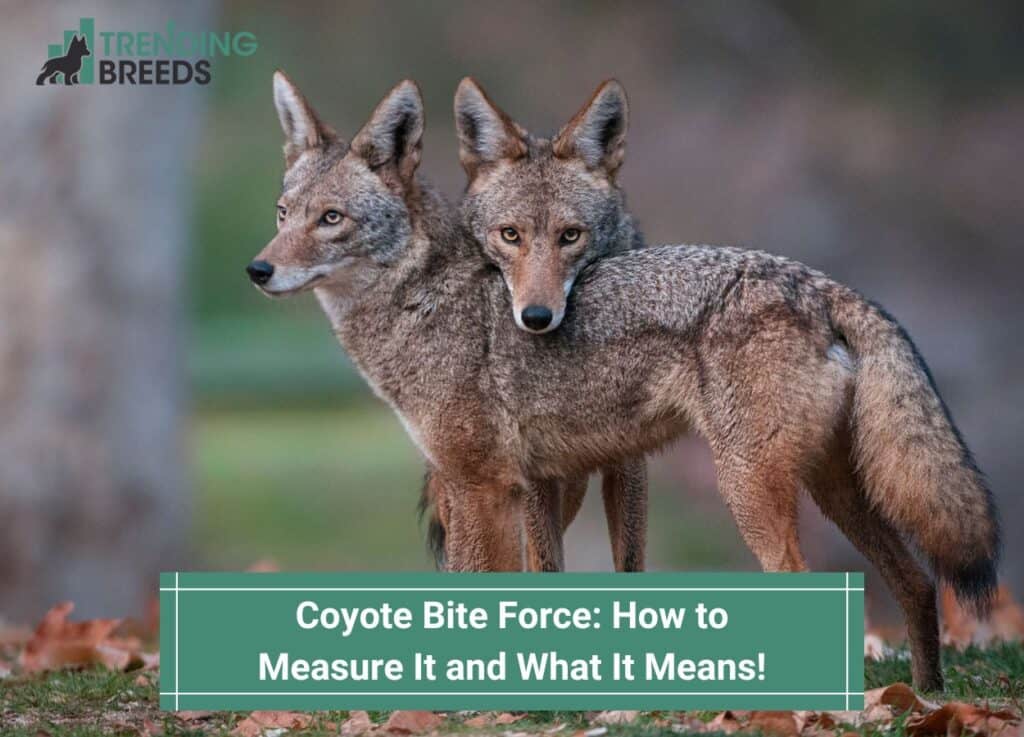
Some people may find coyotes adorable, but they are a strong and rather dangerous species. This is because they live closely alongside humans. They are unlikely to attack, but it’s still possible. So, what is the coyote’s bite force?
The coyote bite force is 88 PSI, which is enough to do significant harm.
However, it is not as strong as a strong dog or a wolf. Nonetheless, you should know what to expect during a coyote attack.
Keep reading below for more information.
Before you scroll further down this guide, check out these other animal-related articles: Why Do Dogs Bite Each Other on the Neck? and The Jaws and Bite of a Cane Corso (Do They Lock?).
Table of Contents
Understanding the Coyote

Coyotes, pet dogs, wolves, jackals, and foxes, are all classified as animals belonging to the family Canidae (Canis latrans).
The southernmost point of their range is Panama, while the northernmost is Canada. Some other names for coyotes include “yotes,” “brush wolves,” and “prairie wolves.”
Regarding their potential for extinction, they are currently ranked as “Least Concern.”
Appearance
Coyotes have bodies that are relatively light for their size and lengthy legs in comparison to their bodies.
The average adult weighs 20-50 pounds and is between 21 and 24 inches tall. Coyotes are easily recognizable by their upright ears and fluffy tails.
Their fur is a red, gray, and white tricolor that allows them to blend in with their surroundings easily. These canids have huge ears that stand up straight and muzzles that are relatively short and thin.
The average coyote has a fluffy tail that descends to a black tip. In contrast to dogs, coyotes keep their tails tucked underneath their bodies as they go.
Temperament
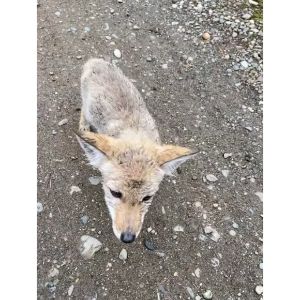
Coyotes do not have a reputation for being hostile. Still, they are wild animals and will do whatever it takes to ensure their survival or that of their offspring.
Coyotes are also excellent hunters and scavengers because they are resourceful, tenacious, and cunning.
To a coyote, there is no difference between a home pet and a wild animal. Depending on their size, coyotes may perceive domestic dogs as either a menace or a tasty meal.
Bite Force of Coyotes
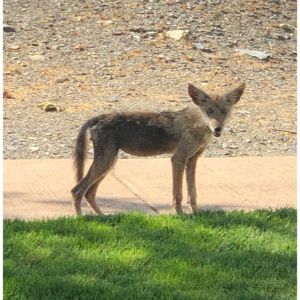
Coyotes can take on larger predators or enemies when hunting in packs thanks to their powerful jaws.
The 88 PSI of biting force is impressive. The 88 PSI that a coyote has cannot be considered a love bite, although it is far less than the 136 PSI that a gray wolf has or the 114 PSI that a large dog has.
The Coyote Jaw and Its Dimensions
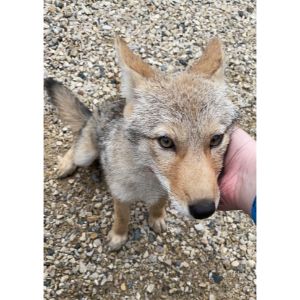
Adults have jaw lengths of about 5.5 inches, with a tooth line that is about 4 inches long. The lower jaw is the thinnest region of their snout, but it also delivers the most force when they bite down.
A coyote’s skull is well adapted for delivering maximum force to the lower jaw, making it an excellent meat eater.
Uses of Coyote Teeth
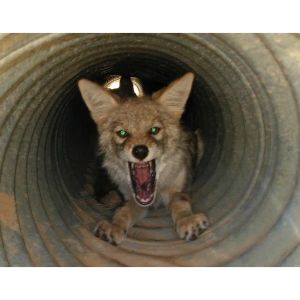
Coyotes are omnivores; therefore, they use all of the different types of teeth they have in various ways when they eat.
The incisors, often known as the front teeth of a coyote, are square-shaped and have sharp edges so that they can help the animal bite and cut its meal.
After the incisors are two canines, each with sharp, pointed teeth designed for snatching and holding onto prey.
Once a coyote has captured its prey, its powerful canines tear at its flesh.
After that, they use their sharp, knife-like cheek teeth to crush and grind everything from vegetables and fruits to insects and fish to the bones of small mammals before swallowing.
Because of their short muzzles, coyotes can sneak into small areas and use their jaws in a refined, functional way.
These canines serve multiple purposes, from cleaning the animal’s coat from insects to catching prey and carrying home young.
Coyotes use their canines for most of their diet, consisting of other mammals and carrion.
A coyote’s diet, which is that of an omnivore, does not consist solely of the meat of small mammals but also contains plant matter. Their pointed molars come in handy when chewing through tough foods like nuts and insects.
Can You Get Bit by a Coyote?
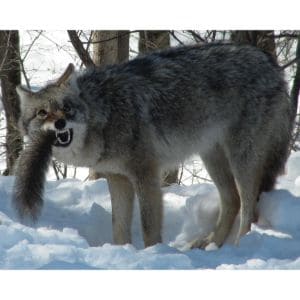
Coyotes have a high propensity to bite humans. But they are more likely to flee or hide when threatened. A person is likelier to be injured by a misdirected golf ball than a coyote’s bite.
However, an old, sick, or hungry coyote will attack a human of any age and even grab a child in the same way it would a rabbit or hare.
It is essential to note that the aggressiveness and assertiveness of coyotes toward people have increased over the past five years.
Children were more likely than adults to be the primary targets of these attacks, up until recently, in August 2021.
Signs of Coyote Bites on Animals
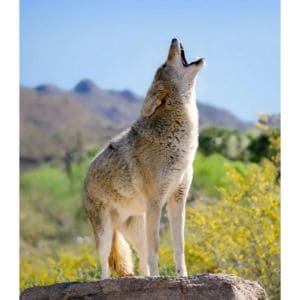
Detecting if a coyote has attacked an animal will be tough unless you’re a trained jaw pattern expert.
They clench down swiftly, then shake their heads and let go. This causes the internal organs to rattle, which causes the animal to collapse.
Identifying Signs
A coyote bite can be hard to detect, but there are certain telltale signs that an animal may have been attacked.
First, the possibility only exists if you know that coyotes are in the area. The next factor that increases this possibility is of blood oozing out of a cut or wound.
Last but not least, the animal’s location matters. Coyote attacks are more likely to occur if there is proof the animal was transported to its current location.
Coyotes would drag their victim over two kilometers away from the hunting ground before they consumed it.
Bite Areas
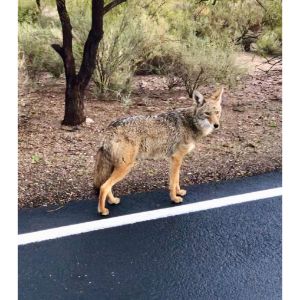
Bite marks are most common on the back of the leg and other parts of the legs of larger, taller animals like deer and bears.
The animal’s throat should also show signs of a definitive bite if it is dead. Bite marks on the shoulders or flanks are another telltale sign.
Tips for Protecting Your Pet from Coyotes
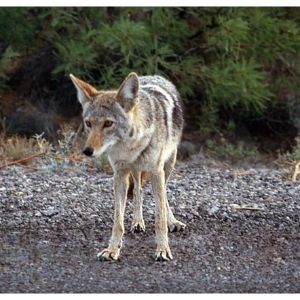
Coyotes constantly threaten domestic animals and won’t go away anytime soon. Here are a few things you can do to lessen the likelihood of a coyote attack:
- Keep in mind that dogs and coyotes might occasionally be attracted to one another. Although it is uncommon, the two species may attempt to mate due to their genetic similarity. Dogs, however, are typically the ones who make the first move.
- When in doubt, feed them nothing. This is why you see more coyotes in residential areas and yards.
- Never give your pet food or water outside. Coyotes will be drawn to your yard with this. Feed your pet outside while it’s still bright out, and then clean up any scraps right away.
- Never let your pet outside without supervision. If you choose to let your pet outside, always keep an eye on them and don’t let them get too far away.
- Use a leash that does not retract to contain your pet. In the case that your pet encounters a coyote, a retractable leash will not provide sufficient control.
- Avoid taking your pet for a walk at night or in the early morning hours. Bring a flashlight if you must take them out at night.
- Protect your pet by giving it a coyote-proof jacket.
How to Keep Coyotes Away
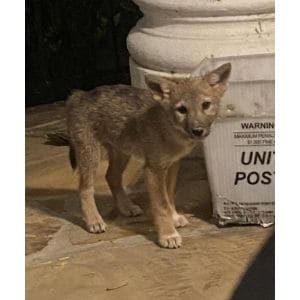
Coyote breeding season is approaching, so be on the lookout. From April through August, these animals are extremely protective of their young.
Coyotes could be drawn to your yard by things like a dirty grill, compost, birdseed, dropped fruit, trash, and unsecured garbage cans, all of which should be removed.
It’s important to keep coyotes out of your yard. Cut back any plants or trees that could provide cover for coyotes.
Fencing designed to keep out coyotes is one option, but motion-activated lighting and watering systems are also effective deterrents.
There is more than one way to get rid of a coyote in your yard if you spot one. Keep your head up and your eyes on the target when you yell, clap your hands, make piercing noises, flash a spotlight, or throw objects.
Do not run away from the animal; approach it quickly and fearlessly.
If you and your pet are out for a walk and you see a coyote, it’s best to make eye contact and slowly back away until you’re at a safe distance.
Coyote Attack: What to Do
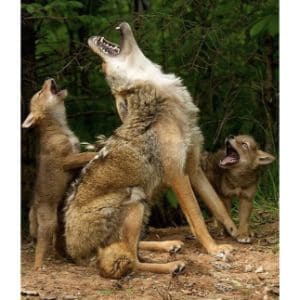
There’s an angry-looking coyote in your way. You can make out the pointed teeth and intimidating glare of the brown eyes. And what is it that you do? If a coyote attacks you, here’s what to do to stay alive:
Stay Put
Don’t ever try to outrun a coyote. If you run, the coyote will become predatory. Instead, gather the kids, pull the dog back on a leash, and retreat. Keep looking at the coyote; you can’t afford to turn your back on it.
Make Some Noise
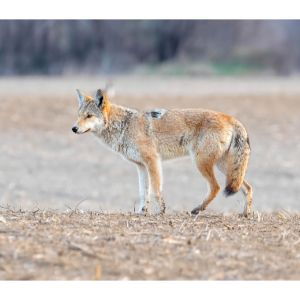
Because of their small size, coyotes avoid conflict with larger creatures. It won’t take much to establish your intimidating size; adults typically weigh around 50 pounds.
Make a lot of noise while waving your arms in the air. Shout at the coyote, clap your hands, and tell it to leave. Use a resounding voice to assert your authority. Make no shrill noises that might attract predators.
Throw Stuff
Throw objects at the coyote if it keeps coming close. Throw anything you can handle, whether rocks, sticks, or even your hiking pack.
Keep looking forward as you throw. Don’t make yourself look small and defenseless by crouching or turning your back on the coyote.
If the coyote doesn’t run away, keep shouting and tossing things. Get ready for a fight if the coyote doesn’t run away.
Frequently Asked Questions
How many teeth does a coyote have?
A coyote has around 42 teeth.
How much weight can a coyote pick up?
A coyote can usually carry around 25 pounds or so. They are not very strong when it comes to carrying away adults.
What smell do coyotes hate?
Vinegar is a strong deterrent against coyotes if they are digging in your trash.
Coyote Bite Force: How to Measure It and What It Means

It can be scary to encounter a coyote attack because of their strong bite force that measures at approximately 88 PSI.
But now that you know what to do in case of a coyote attack, your chances of surviving one are much better.
If you find this guide, “Coyote Bite Force: How to Measure It and What It Means,” informative and helpful, you can check out these other animal-related articles from our team:
- Can a Blue Heeler Kill a Coyote?
- Can Dogs Breed With Foxes? With Coyotes, Wolves, or Hyenas?
- Are Blue Heelers Protective?
You can learn more about coyotes by watching “22 Fun and Amazing Facts About Coyotes” down below:




